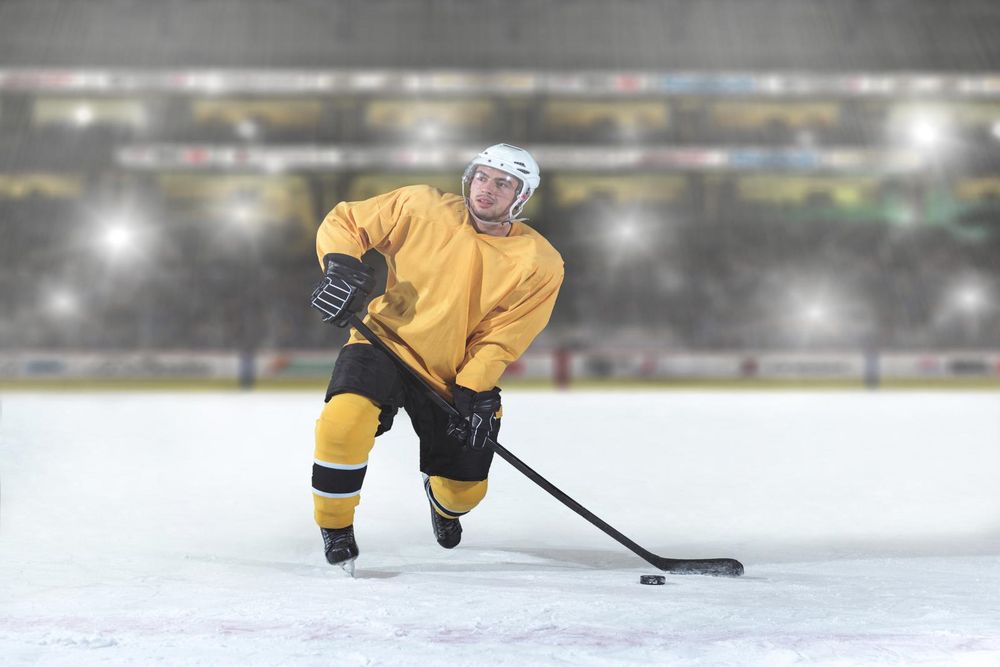Like a shield protecting a knight in battle, mouth guards are a vital defense for hockey players, shielding their teeth and jaws from potential harm. However, it is a curious sight to witness players chewing on these protective devices during gameplay.
Why do they engage in this habit, and what are the consequences? In this article, we explore the motivations behind this practice, the problems associated with ill-fitting mouth guards, and the importance of finding the perfect fit for comfort and protection on the ice.
Reasons for Chewing on Mouth Guards
Hockey players chew on their mouth guards for various reasons, including increasing focus and it being a common practice among players. Chewing on a mouth guard helps players concentrate on the game by providing a sensory input that keeps them engaged. Additionally, some players simply prefer the sensation of chewing on their mouth guard during play.
However, there are potential issues with chewing on mouth guards. Constant chewing can lead to improper functioning of the mouth guard, impacting its ability to protect against dental injuries. Ill-fitted mouth guards can be bothersome and distracting, requiring constant adjustments during play. Mass-produced mouth guards may not provide a snug fit for most players, compromising both comfort and protection.
To address these concerns, custom-fit mouth guards are recommended. Dentist impressions ensure a perfect fit for individual players, eliminating discomfort and looseness. Well-fitting mouth guards are crucial for protecting against jaw and teeth injuries, distributing impact evenly, and preventing chipped or broken teeth.
Uncomfortable Fit of Mouth Guards
The discomfort caused by ill-fitted mouth guards can hinder players’ performance and pose potential risks to their dental health. When a mouth guard doesn’t fit properly, it can be bothersome and distracting for players. Constantly rearranging the mouth guard takes their focus away from the game.
Mass-produced mouth guards may feel too large for most players, leading to an uncomfortable fit. However, there are cost-effective alternatives to ensure a better fit. Custom-fit mouth guards, obtained through dentist impressions, eliminate discomfort and looseness.
Well-fitting mouth guards are crucial in preventing dental injuries. They absorb impacts to the jaw and mouth area, distributing the force evenly and protecting against chipped or broken teeth. Properly worn mouth guards can save players from costly dental reconstructions.
It is essential to prioritize the fit of mouth guards to ensure players’ comfort and dental safety.
Increased Focus Through Chewing
Chewing on mouth guards during play has been observed to enhance players’ concentration. Here are some benefits and drawbacks of chewing for increased focus:
- Enhanced Alertness: Chewing on a mouth guard stimulates the brain, increasing alertness and focus on the game. It helps players stay in the moment, react quickly, and make better decisions.
- Stress Reduction: Chewing can alleviate stress and anxiety, allowing players to stay calm and focused under pressure. It serves as a coping mechanism during intense gameplay, promoting mental resilience.
- Ritualistic Comfort: Chewing on a mouth guard has become a common practice among hockey players. It provides a sense of familiarity and belonging, creating a psychological boost that enhances concentration.
- Mouth Guard Damage: Consistent chewing can lead to the improper functioning and damage of mouth guards. It increases the need for frequent replacements, compromising the protection they provide.
While chewing on mouth guards can offer increased focus benefits, players must be aware of the drawbacks and ensure they strike a balance between concentration and mouth guard care.
Common Practice Among Hockey Players
A prevalent behavior among hockey players is the habitual chewing of their mouth guards. But why do they do it? There are a few reasons behind this common practice.
First, some players find their mouth guards uncomfortable and chewing helps alleviate that discomfort.
Second, chewing on the mouth guard can help increase focus and concentration during the game.
However, there are potential dangers associated with this behavior. Chewing on the mouth guard can lead to improper functioning, rendering it less effective in protecting against dental injuries. Additionally, consistently chewing on the mouth guard can damage it, resulting in the need for frequent replacements.
To avoid these potential issues, it is recommended to use chew-resistant or custom-fit mouth guards that provide both comfort and protection.
Improper Functioning of Mouth Guards
Consistently chewing on mouth guards can result in decreased effectiveness and functionality. Improper functioning of mouth guards can lead to potential damage from chewing, compromising their ability to protect players during hockey games. To understand the implications of improper functioning, consider the following:
- Reduced Protection: Mouth guards that have been chewed on may not provide adequate protection to the jaw and teeth. This puts players at a higher risk of dental injuries, including chipped or broken teeth.
- Weakened Structure: Chewing on mouth guards can weaken their structure, making them less durable and more prone to wear and tear. This increases the need for frequent replacements, which can be costly.
- Sacrificed Comfort: Mouth guards that have been chewed on may become uncomfortable and ill-fitting, causing distractions and discomfort during gameplay.
- Limited Lifespan: The constant chewing on mouth guards can significantly decrease their lifespan, necessitating more frequent purchases and replacements.
To ensure proper protection and longevity of mouth guards, it is essential to avoid chewing and opt for chew-resistant or custom-fit options.
Preference for Chewing During Play
During gameplay, many hockey players have developed a preference for chewing on their mouth guards as a means of increasing focus and maintaining their comfort. This chewing habit has become a common practice among hockey players, with some players finding it beneficial for their performance on the ice.
To understand the impact of chewing on mouth guards, let’s take a look at the following table:
| Chewing Habits | Impact on Performance |
|---|---|
| Increases focus | Helps players stay in the zone and concentrate on the game |
| Provides comfort | Relieves stress and anxiety, allowing players to perform at their best |
| Improves breathing | Chewing helps regulate breathing, ensuring a steady supply of oxygen to the muscles |
While chewing on mouth guards can have positive effects on performance, it is important to note that excessive chewing can lead to improper functioning of the mouth guard, compromising its protective qualities.
Players should find a balance between chewing for focus and comfort and ensuring the mouth guard remains intact and functional throughout the game.
Issues With Ill-Fitted Mouth Guards
The discomfort caused by ill-fitted mouth guards can be bothersome and distracting for hockey players. Here are some of the issues that arise from wearing ill-fitting mouth guards:
- Constant adjustment: Ill-fitted mouth guards require constant rearranging during play, leading to a loss of focus and concentration on the game.
- Size issues: Mass-produced mouth guards often feel too large for most players, causing discomfort and a lack of stability.
- Lack of protection: Ill-fitting mouth guards fail to provide adequate protection against jaw and teeth injuries. They may not absorb impacts properly or distribute them evenly, leaving players vulnerable to chipped or broken teeth.
- Custom-fit solution: Custom-fit mouth guards, made through dentist impressions, eliminate discomfort and looseness. They ensure a perfect fit for individual players, providing comfort and optimal protection.
Bothersome Ill-Fitted Mouth Guards
One major drawback of ill-fitted mouth guards is the discomfort they cause for hockey players. When the mouth guard does not fit properly, it can rub against the gums, causing irritation and soreness. This discomfort can be distracting during gameplay, affecting a player’s focus and performance.
Ill-fitted mouth guards are often mass-produced and may feel too large or loose for most players. This not only leads to constant readjustment but also compromises the effectiveness of the mouth guard in protecting the player’s teeth and jaw. Dental injuries can result in costly dental reconstructions, making a well-fitting mouth guard a cost-effective solution.
Custom-fit mouth guards, created through dentist impressions, ensure a perfect fit for individual players, providing both comfort and optimal protection. By investing in a well-fitting mouth guard, hockey players can minimize discomfort and reduce the risk of dental injuries.
Distracting Constant Rearrangement
Constant rearrangement of ill-fitted mouth guards can be a persistent distraction for hockey players, impeding their focus and performance on the ice. This distraction can have detrimental effects on their ability to fully engage in the game and make split-second decisions. To prevent such distractions, players can explore alternatives to chewing on their mouth guards.
Here are some options to consider:
- Custom-fit mouth guards: These provide a snug fit and eliminate the need for constant adjustment. They are specifically designed to fit an individual player’s mouth, ensuring optimal comfort and protection.
- Chew-resistant mouth guards: These mouth guards are made from durable materials that are less likely to be damaged by chewing. They can withstand the repetitive movements of the jaws without compromising their functionality.
- Proper fitting techniques: Players should be educated on how to properly wear their mouth guards to minimize the need for constant rearrangement. This includes ensuring the mouth guard is securely in place and properly aligned with the teeth.
- Regular maintenance: Regularly inspecting and cleaning the mouth guard can help identify any issues that may contribute to constant rearrangement. Additionally, replacing worn-out mouth guards timely can prevent distractions during gameplay.
Size Issues With Mass-Produced Mouth Guards
Players often encounter size issues with mass-produced mouth guards, which can hinder their comfort and overall effectiveness on the ice. Ill-fitting mouth guards can be bothersome, constantly requiring adjustment and causing distraction during intense gameplay.
Mass-produced mouth guards may feel too large for most players, leading to discomfort and a compromised fit. This improper protection can leave players susceptible to jaw and teeth injuries. To address this issue, custom-fit mouth guards are recommended. Dentist impressions ensure a perfect fit for individual players, eliminating discomfort and looseness.
While custom-fit mouth guards may have a higher initial cost, they can be more cost-effective in the long run. Consistently chewing on mass-produced mouth guards increases the need for frequent replacements, making custom-fit guards a valuable investment for players seeking both comfort and protection.
Comfort and Fit of Custom-Fit Mouth Guards
A well-fitting custom mouth guard ensures optimal comfort and protection for hockey players on the ice. When it comes to mouth guards, custom-fit options offer several benefits that make them superior to mass-produced alternatives. Here are four reasons why custom-fit mouth guards are worth considering:
- Perfect fit: Custom-fit mouth guards are made from dentist impressions, ensuring a snug fit for individual players. This eliminates discomfort and looseness, allowing players to focus on the game rather than their mouth guard.
- Enhanced protection: Ill-fitted mouth guards leave players vulnerable to jaw and teeth injuries. Well-fitting mouth guards absorb impacts and distribute them evenly, protecting against chipped or broken teeth. This can save players from costly dental reconstructions.
- Cost-effective in the long run: While custom-fit mouth guards may have higher upfront costs, they can be more cost-effective in the long run. Mass-produced mouth guards often sacrifice protection and comfort, leading to frequent replacement. Custom-fit options, on the other hand, are durable and offer better value for money.
- Comfort and confidence: A properly worn mouth guard should be hardly noticeable during play. Custom-fit mouth guards eliminate the need for constant adjustment, providing a comfortable and secure fit that boosts players’ confidence on the ice.
Importance of Well-Fitting Mouth Guards
The importance of well-fitting mouth guards lies in their ability to provide optimal protection and comfort for hockey players on the ice. Ill-fitted mouth guards can be bothersome, constantly requiring readjustment and causing distractions during play.
Mass-produced mouth guards may feel too large for most players, resulting in discomfort and looseness. This not only affects the player’s focus but also leaves them susceptible to jaw and teeth injuries. Well-fitting mouth guards, on the other hand, absorb impacts to the jaw and mouth area, distributing the force evenly and protecting against chipped or broken teeth. They can save players from costly dental reconstructions and prevent dental injuries.
While chew-resistant mouth guards or custom-fit ones may seem more expensive initially, they prove to be cost-effective alternatives in the long run, as they eliminate the need for frequent replacements and provide superior protection.
Frequently Asked Questions
How Can Chewing on Mouth Guards Lead to Dental Injuries?
Chewing on mouth guards can lead to dental injuries due to the repetitive force exerted on the guard, causing it to become less functional. Alternative methods, such as chew-resistant or custom-fit mouth guards, are recommended to prevent damage.
Are There Any Alternatives to Chewing on Mouth Guards for Increasing Focus?
There are alternative methods for increasing focus in hockey players without chewing on mouth guards. Mindfulness exercises and fidget toys can help players stay engaged and focused during the game.
What Are Some Common Misconceptions About Ill-Fitted Mouth Guards?
Misconceptions about ill-fitted mouth guards include the belief that discomfort is normal, and that constantly adjusting the guard is necessary. However, a well-fitting mouth guard is crucial for player safety, preventing jaw and teeth injuries, and ensuring optimal performance.
How Do Custom-Fit Mouth Guards Ensure a Perfect Fit for Individual Players?
Custom-fit mouth guards ensure a perfect fit for individual players by utilizing dentist impressions. This level of customization eliminates discomfort and looseness, providing benefits such as enhanced protection, improved comfort, and reduced need for frequent replacements.
What Are the Potential Long-Term Consequences of Consistently Chewing on Mass-Produced Mouth Guards?
Consistently chewing on mass-produced mouth guards can have long-term consequences on dental health. It can damage the mouth guard, compromising its protection and comfort. Custom-fit mouth guards are recommended to prevent these issues and ensure optimal dental safety.
Conclusion
In conclusion, the habit of chewing on mouth guards among hockey players can be attributed to reasons such as discomfort, increased focus, and common practice. However, this behavior can lead to problems with the functioning of the mouth guard and constant rearrangement.
Ill-fitted mass-produced mouth guards often contribute to these issues. To ensure both comfort and protection, it is important for players to opt for well-fitting custom-fit mouth guards.
Interestingly, studies have shown that nearly 50% of hockey players engage in the habit of chewing on their mouth guards, emphasizing the need for better education and awareness on this topic.









